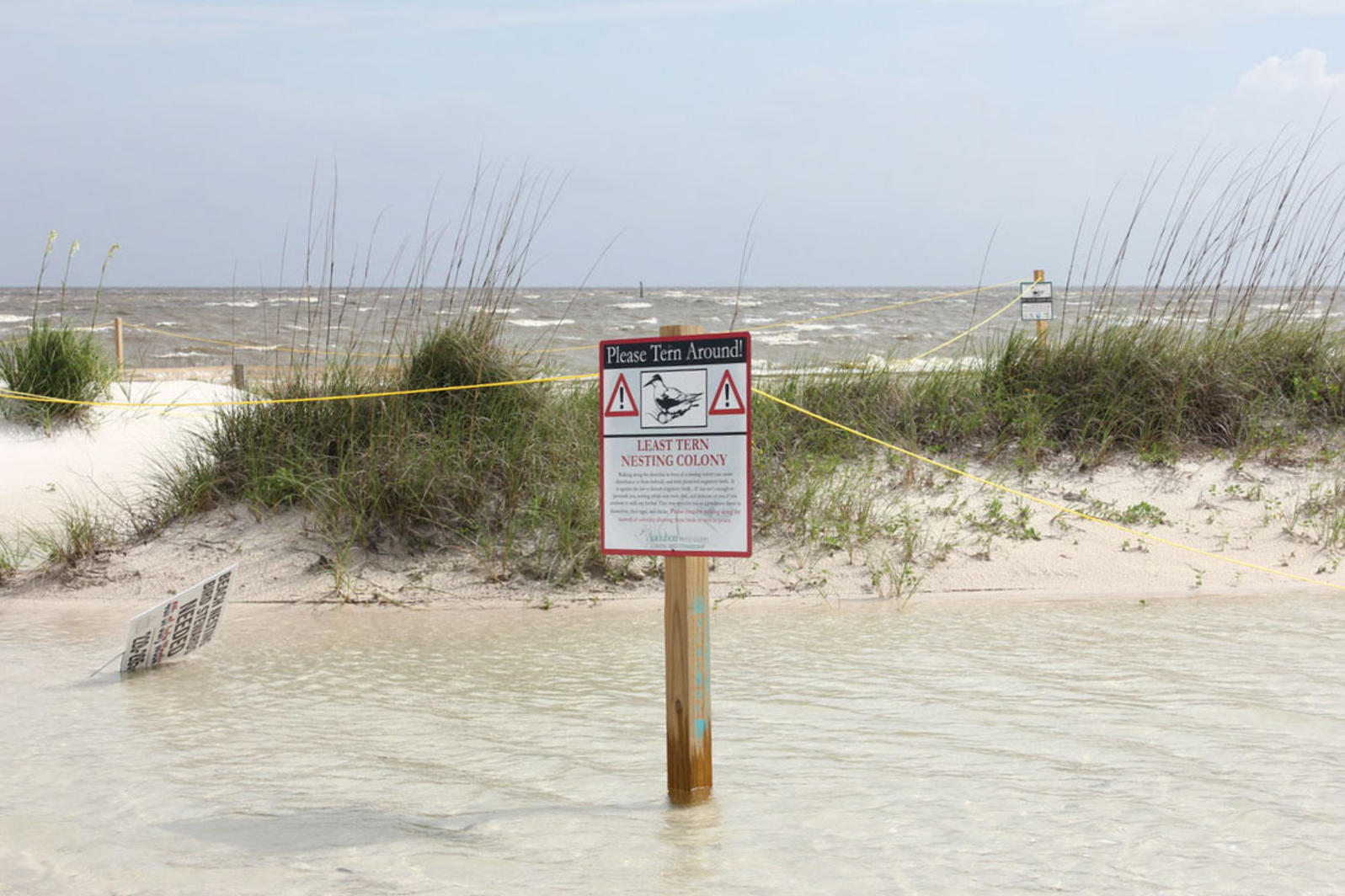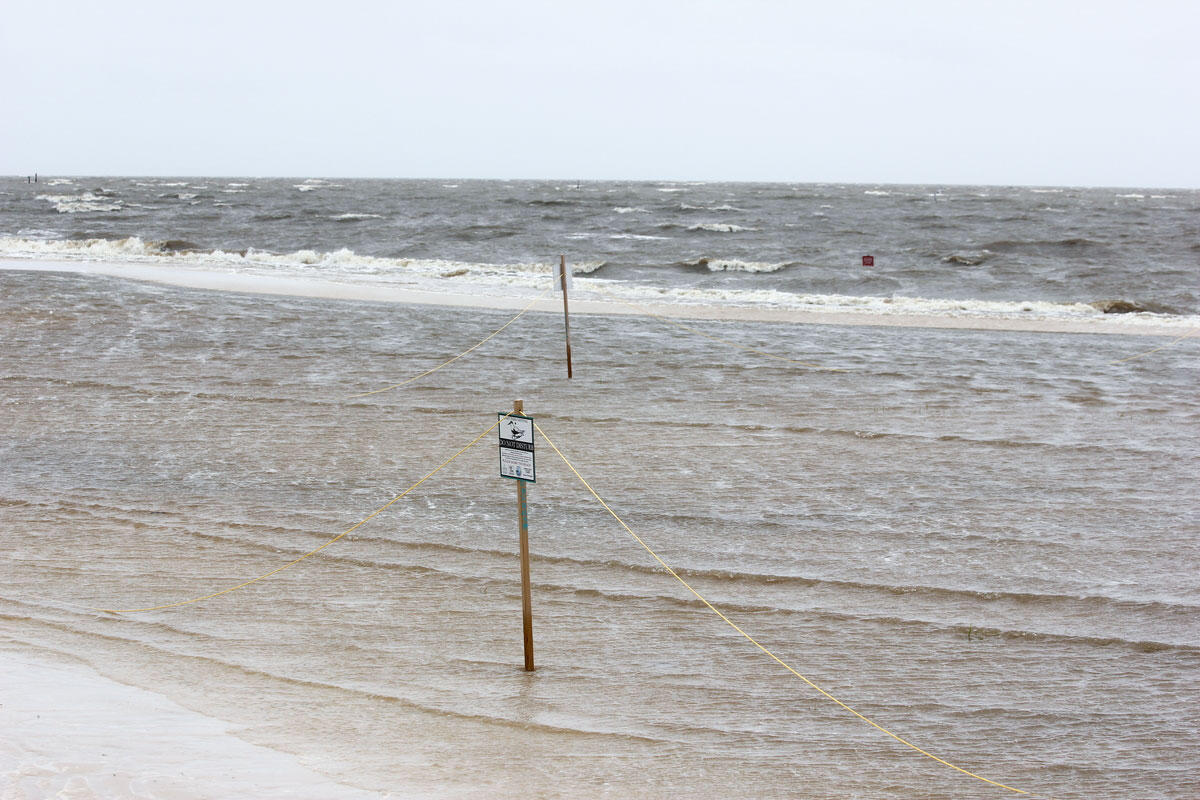Tropical Storm Cindy Just Wiped Out Most of the Shorebird Chicks in the Gulf
Without coastal restoration that makes beaches less vulnerable to storm surges, climate change will be a threat, and not just from sea level rise.
Originally posted on Audubon.org on June 27, 2017.

A Least Tern colony, marked by signs and twine, was submerged after Tropical Storm Cindy hit the Gulf Coast last week. Photo: Abby Darrah.
This week, communities ringing the Gulf of Mexico are assessing damages and cleaning up after being hit by Tropical Storm Cindy, which made landfall in southwestern Louisiana on Friday and caused heavy rain, floods, high winds, and tornadoes through the weekend. The region’s shorebird biologists are in poor spirits: The storm wrecked nesting shorebirds, and many recently hatched chicks drowned because they were not yet old enough to fly away and escape flooded beaches.
Audubon biologists are currently surveying hundreds of nests along the Gulf coast, and full results won’t be available for several weeks. But the preliminary reports do not look good. Throughout the Gulf, at least half of most shorebird nests and chicks were washed out. Birds that nest on low-lying beaches were hit the hardest, including Least Terns, Wilson’s Plovers, and Black Skimmers.
- In Cameron Parish in southwest Louisiana, biologists haven’t seen any downy young chicks among the dozens of nests, although some older, feathered chicks, more secure on their feet, escaped the high tides that inundated beaches. In southeast Louisiana, just 21 out of 64 Least Tern nests survived.
- At Mississippi’s largest Least Tern colony, wedged between a Jet Ski vendor and a beach chair rental stand, floodwaters washed out all but 56 chicks; a week ago, 302 chicks lived there.
- In Florida, Black Skimmer and Least Tern nests and chicks were almost entirely washed out on all offshore islands in the eastern panhandle, and many Gull-billed Tern nests were lost, too. On the mainland in Pensacola, the Least Tern nest count went from 62 to 28, and only 17 of 33 chicks survived the storm.
Most of the Gulf’s surviving downy chicks escaped the floodwaters only because their parents nested on higher ground. On Mississippi’s manicured white sand beaches, feathered tern chicks were able to run and hide behind small manmade dunes. On Elmer’s Island in Louisiana, tern nests on the highest peak of a recently reconstructed dune made it, alongside the island’s only surviving Wilson’s Plover nest. And in Florida, Brown Pelicans that built nests of sticks were able to ride out the storm.

A young, downy Least Tern chick on Mississippi’s shores before the storm. Chicks this age are too helpless to fly or run away from floodwaters. Photo: Bryan White.
As bad as Tropical Storm Cindy was, it was actually the second wave of floodwaters these birds endured this year. In early May, an unnamed stormed caused several feet of tidal flooding along the coast, enough to swamp nesting grounds just as birds began breeding. It was early enough in the season to re-nest, and many Least Terns and Wilson’s Plovers did just that.
Then this recent tropical storm hit them at just the wrong time, again, when chicks had hatched but weren’t able to fly. “Couldn’t Cindy have waited a few more weeks?” says Doug Meffert, National Audubon’s vice president for the Gulf Coast and Mississippi Flyway. “It’s so early in the hurricane season.”
According to Erik Johnson, director of bird conservation for Audubon Louisiana, Least Terns may attempt to nest a third time, but Wilson’s Plovers will probably skip this year. If they laid new eggs now, the chicks wouldn’t fledge until the end of August—and the species typically prepares for migration during July.
“The one-two punch and the timing of these is really challenging,” Johnson says. “We know at this point it’s not a good nesting season. How good or how bad it is—those are little tweaks that we will figure out over the next month.”

Stakes and twine that alerted beachgoers to nesting Least Terns show the outline of the nesting area where chicks drowned after Tropical Storm Cindy. Photo: Abby Darrah.
Beach-nesting species like Least Terns and Wilson’s Plovers are long-lived and therefore can sustain the occasional lost nesting season. But increased storm frequency and intensity, along with sea level rise, caused by climate change could overwash their nests more than occasionally. “If you have the increasing intensity of summer storms every year, the land is sinking, and you get these multiple storms in sequence—it’s really not an optimistic scenario for these birds,” Johnson says
Climate change is predicted to cause more coastal flooding from a combination of rising sea levels and more intense storms that bring larger storm surges. Over the long term, creating nesting habitat far above high tide will be necessary to protect beach-nesting species. Throughout the Gulf, Audubon chapters and state offices are building support and helping advance restoration of coastal habitats to create more nesting space for shorebirds and, simultaneously, create land buffers to protect inland communities from storms. And as stewards, Audubon volunteers and staff identify and protect nests, and help raise public awareness about threats to the birds.
“There are always going to be storms and there are always going to be hurricanes,” Johnson says. “But we can make that system more resilient and make events like this less traumatic.”